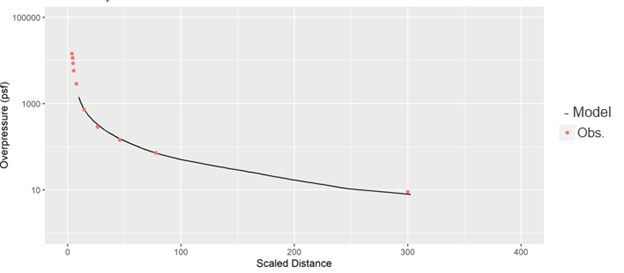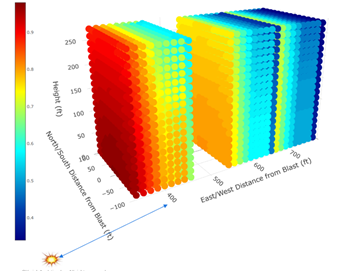Catastrophe models are intended for loss estimation, so it is critical they are validated to ensure their reasonability. While the most important validation is whether the model can reproduce reasonable indications of physical damage and financial loss for historical events, Verisk’s rigorous validation process is not limited to the final model results. As our models are updated to take advantage of new advances in technology and enhanced data, model results improve. Verisk models are built from the bottom up. Throughout the development process, we validate each component individually against data from historical events as well as experimental and analytical study. In addition, the loss estimates for past events produced by our models are validated against loss reports for historical events, so we validate our models from the top down as well.
The recently updated Verisk Terrorism Model for the United States, for example, enables both stochastic and deterministic event modeling, which estimate property and workers' compensation claims due to a potential conventional, chemical, biological, radiological, or nuclear attack in all areas of the U.S. The model’s most common use case is therefore the estimation of damage from blasts in urban locations.
Urban landscapes can be a jumble of buildings of differing size and construction interspersed with open spaces. Such a configuration can interact with blast waves resulting in complex wave propagation and intensity footprints resulting from reflections and diffractions (passages through narrow openings or across edges, typically accompanied by interference between the wave forms produced) in all directions.
Technically, intensity propagation through a variety of urban environments could be modeled accurately using 3D Computational Fluid Dynamics (CFD) simulations. But because it is not practical to perform this kind of complicated simulation in the context of portfolio analyses, we place the built environment into five classes to differentiate wave propagation within different built environments. The classes range from open spaces to high-intensity urban canyons of the kind seen in downtown New York City, San Francisco, and Chicago.
Verisk engineers conducted extensive literature reviews and 3D CFD analyses in different built environments to advance the understanding of wave propagation. This research led to realistic intensities and attenuation between scaled distances, particularly in urban canyons. In addition to more accurate overpressure estimation, pressure impulse (proportional to both overpressure and its duration) is used in the model and this enhances the damage estimation by blast size. Figure 1 shows the validation of overpressure by distance for the 1995 Oklahoma City bombing modeled as an urban density mix of middle- and high-rises.

Verisk’s U.S. terrorism model damage estimation is akin to a surrogate 3D calculation. Every risk is assumed as a dimension (width, depth, and height) based on its occupancy and number of stories centered at its input latitude and longitude; it is then discretized into 14-foot cubic cells small enough to ensure uniform damage within each cell. Intensities are calculated cell by cell as both entering and leaving intensities, and damage is calculated through the aggregation of cells for building and contents/injury by entering and leaving intensities, respectively. This discretization is critical to more accurate estimation, as it enables damage estimates for a specific floor of interest.
Validation from the Top Down
Using the Verisk U.S. terrorism model, we subjected three risks in Manhattan to a 6-ton blast. The three risks had the same attributes: 20-story commercial reinforced concrete buildings located 400, 600, and 700 feet from the blast. Figure 2 shows a 3D illustration of building physical damage by cells in the model, where warmer colors indicate higher damage: the front of a building experiences more severe damage than its rear; and the rear of the building 400 feet from the blast experiences less damage than the front of the building 600 feet from the blast, reflecting the shielding effects that could be typically modeled in 3D CFD analyses. Results from Verisk’s U.S. terrorism model replicate the damage observed in the 1995 Oklahoma City bombing and the 1996 Khobar Tower blast where the fronts of buildings were blown off but contents in rear cells could be salvaged and their occupants could survive. Without the current model’s capabilities, the observed damage could not be reasonably replicated.

Figure 3 illustrates the modeled physical damage in a 3D view of the 1995 Oklahoma City bombing showing the close match between modeled and observed physical damage to the Murrah Building, the target of that attack.
The Verisk U.S. terrorism model generally produces a damage footprint that agrees well with the reproduction of the 1995 Oklahoma City bombing observations. The model is also able to replicate the reported monetary loss using the high-resolution Verisk U.S. industry exposure database for both the 1995 Oklahoma City (insured loss) and 1993 World Trade Center (ground-up loss) bombings and the breakdown by coverage is found reasonable. Verisk’s U.S. terrorism model has been used to compare with Lloyd’s and Federal Insurance Office (FIO) realistic disaster scenarios with results falling between the respective prescribed estimates.
In addition, the model has validated well in case studies involving the 2013 Boston Marathon bombing and a 2020 Beirut-size blast. These incidents—one modest in scale and the other enormous—were selected for analysis to check model performance subjected to a wide range of explosions. For the Beirut study, it is assumed the urban density is a built-up area with a mix of low- and mid-rise buildings, and the damage footprint is calculated as if there were a hypothetical uniformly gridded exposure of two-story concrete apartment buildings—the most common type of structure in the Port of Beirut area—and therefore a good proxy for the damage severity and extent study. The size of the Beirut blast is much larger than any of the conventional weapon sizes available in Touchstone®, but the modeled damage extent and severity for this event obtained using the model nevertheless agreed well with observations from the explosion in Lebanon.
What Makes the Verisk U.S. Terrorism Model Best in Class?
The man-made peril of terrorism poses unique risks when compared to some natural catastrophes. It may exhibit cyclic behavior influenced by, for example, a national political climate, significant religious events, or anniversaries of past terrorist attacks. And it may be coupled in the near future with the impact of the worsening climate crisis on some socio-economic classes globally (Somers, 2019). Terrorism has also been accelerated in recent years by social media platforms and online resources spreading misinformation and radicalizing individuals. These circumstances drive the need for insurers to acknowledge, understand, and account for terrorism.
The Verisk U.S. terrorism model provides the following capabilities and more, which make it a powerful tool for assessing terrorism risk:
- 3D Computational Fluid Dynamics (CFD) simulations have been conducted to improve intensity propagation through a variety of urban environments
- Multiple intensity measures are used to provide a realistic estimation of damage for building exterior and interior using a surface damage function
- The loss calculation framework and cellular damage aggregation approach permit detailed loss results for a specific floor of interest
- The 10-ton medium truck blast size allows users to simulate a great variety of scenarios
- Attack frequency could be adjusted through Model Builder
- Expanded to explicitly model damage for infrastructures and large industry facility
Every component of this model has been validated with observations from historical events and published literature to ensure confidence in the modeled results; damage to highways is validated by the reproduction of the 1995 Oklahoma City Bombing crater size, for example. The Verisk Terrorism Model for the United States allows insurers and reinsurers to estimate the potential property, business interruption, workers’ compensation, and personal injury losses that can arise from acts of terrorism.
The deterministic event modeling capabilities in Touchstone® allow you to select a blast size and location to analyze the impact it will have on your specific book of business. This complements the exposure aggregation capabilities provided by Touchstone’s Geospatial Analytics Module, which can leverage dynamic ring analysis to identify locations corresponding to maximum exposure concentrations. The ability to leverage both of these capabilities makes the U.S. Terrorism Model in Touchstone best in class for estimating terrorism risk in the United States.
Discover hidden risks and manage your exposure with the Verisk Model for Terrorism.




